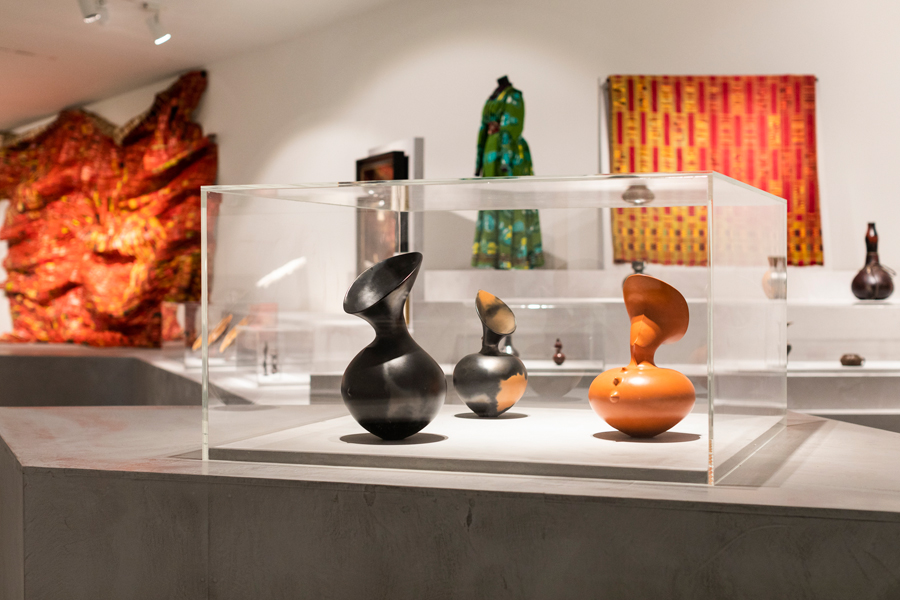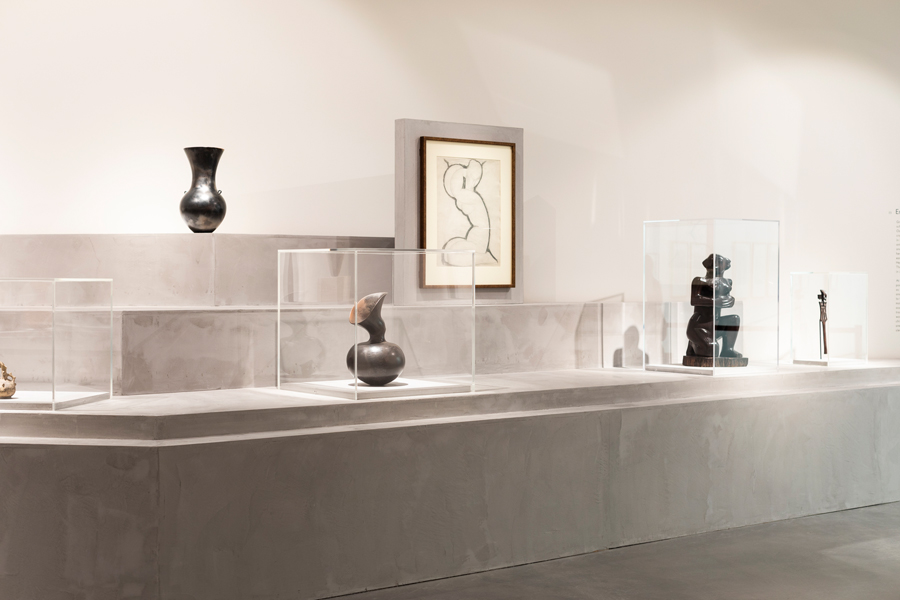The Living and the Dead: Magdalene Odundo’s Philosophy of Vessels
The artist discusses her new show at The Hepworth Wakefield: ‘Ceramics for me is so personal: it’s so painful to produce sometimes’
The artist discusses her new show at The Hepworth Wakefield: ‘Ceramics for me is so personal: it’s so painful to produce sometimes’

At the Hepworth Wakefield, Magdalene Odundo has placed her burnished, broad-bellied, anthropomorphic vessels in diverse company. Her exhibition ‘The Journey of Things’ – situating 50 of her ceramic sculptures from the 1970s to the present among ancient and modern artworks – suggests a voyage of the eye. There are nods to Odundo’s formation; ceramic vessels by Michael Cardew, Zoe Ellison, and Henry Hammond, all of whom taught her in the UK after she moved from Kenya in 1971; a water pot by Ladi Kwali with whom Odundo studied in Nigeria, during subsequent trips to explore African ceramic traditions. Her eye has not stopped journeying. To the knowledge acquired in Africa she added expertise from Asia, Central and South America: journeys represented in Wakefield by art and ceremonial objects relating to the human form. Odundu’s long engagement with Modernist sculpture – and its borrowings from African art – is embodied in pairings of her works with drawings by Pablo Picasso and Amedeo Modigliani, and sculpture by Bernard Meadows, Jean Arp and Henri Gaudier-Brzeska.

Hettie Judah: Thinking about your work, and then walking into this museum and seeing the familiar Barbara Hepworth sculptures, my understanding of her works flipped. I’ve not thought of Hepworth making vessels before, but of course her sculptures have hollows and they have holes. How do you relate her work to yours?
Magdalene Odundo: I knew Barbara Hepworth’s work even before I came to England. For me, the hollowing, the carving, the extracting – what remains or what’s taken out – is quite important, because in sculpture she’s creating voids from a block, whereas I’m creating space by making it. Clay you form.
HJ: You’ve used colour strongly but sparingly in this exhibition. To what degree is there chance in the way that you use it?
MO: Well, there is chance: it’s deliberate! It’s not left to accident: if it comes out of the kiln in a way that doesn’t work for that piece, it would go back into the fire. It could be fired five times, so I actually designed that accident.

HJ: Over the years, you’ve stayed true to vessel forms. There’s this suggestion of function, that you could carry something, in each of these works.
MO: To me, the vessel as a container is a concept that is so philosophically important. It has containment but it also un-contains: it will also pour out because the emotions of taking in and letting go are so important to the living and the dead. Coming from a culture that is very steeped in ancestral life, for us, for me, the death of my parents is a biological thing but they exist, you know? We name our children after them so that you can relate to them as ‘they’ – our mothers and fathers – we don’t relate to them as the dead and the gone.
HJ: So we may perceive these vessels as empty, but they are carrying a lot in them?
MO: They’re not empty. They carry. They contain. They have to have an opening because they have to breathe out because otherwise they will burst, like a balloon.
HJ: It’s interesting seeing your work here next to Geometry of Fear-type postwar sculptures. Those are like skeletons but yours are more like skins. Your work is the outside form: theirs is stripped back to the mechanics.
MO: Yes, but the anger is contained within it.
HJ: Some of your works are quite aggressive: the tensed position of the necks and the bristling spurs like the bones of the spine.
MO: I know. It’s almost like the dance of the devils – or it can also be the dance of the angels – the ancestral world we don’t know. In my house growing up, if you mentioned somebody as if they were dead, people would think you’ve been bewitched because they’re there. They just have gone to visit. That’s why we have a lot of ceremonies. My ‘Kigango’ series (2010-13) is a celebration of the anniversary of the dead so that the spirits can continue to appease and to look after you. We please them, we feed them so that they don’t come back in anger and wreak havoc. I like the fact that the pieces have this duality in them: that they can be peaceful but they also create conflict.
HJ: You mentioned dance: there is definitely a sense that they’re moving together. The paired vessels Twins (2013) feel like two children, one sticking his finger out the back and the other wanting to reach forward and touch it. In your preparatory drawings the forms register less like vessels than, say, a man’s neck and a high collar. Do you conceive of them as portraits at all?
MO: I think they are. I make two or three pieces at the same time: you have to, that is the nature of working clay. Each piece is then treated differently or individually and then brought together. They work very much together as a pair. I think they all have to maintain their own personality because each piece is not going to always have a pair. There are very few people who want to have two – they just want one – so that piece has to have its own personality, it has to be that principle dancer who does the pirouette on their own, and we clap because they’ve frozen.

HJ: You’ve also been working with glass for a while. How much is the form dictated by the materials? Your glass works are quite different.
MO: The glass works are different because they’re collaborative. I don’t make the glass, they’re made for me. Before clay is fired it is still very plastic; even when it’s dry you can put it back in water and rework it. But [on firing] it’s one of the few materials that become permanent: if a work breaks it would become shards, whereas you can put broken glass back in the kiln: the fluidity of it is totally different. In most cases, glass becomes a collaborative piece of work. Ceramics for me is so personal: it’s so painful to produce sometimes. I have battles with it to try and get the gestures that I want. It’s pleasurable when it’s actually going well and you can stand on your tiptoes and mimic it, but to get that stance is very difficult.
HJ: How was it seeing your early work at Hepworth?
MO: A shock. I had forgotten I’d made it. One I made in the last year of my undergraduate course when I was still working on techniques, mimicking Ladi Kwali. It feels like learning.
‘Magdalene Odundo: The Journey of Things’ is on view at The Hepworth Wakefield until 2 June 2019.
Main image: Magdalene Odundo, ‘The Journey of Things’, 2019, installation view, The Hepworth Wakefield. Courtesy: the artist and The Hepworth Wakefield






















